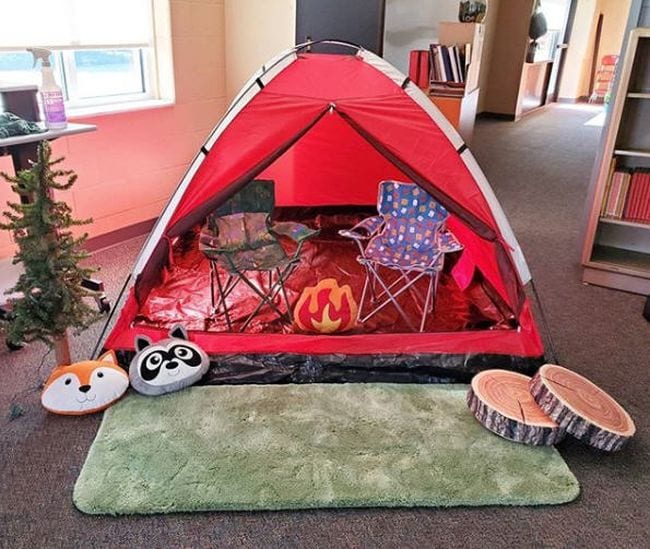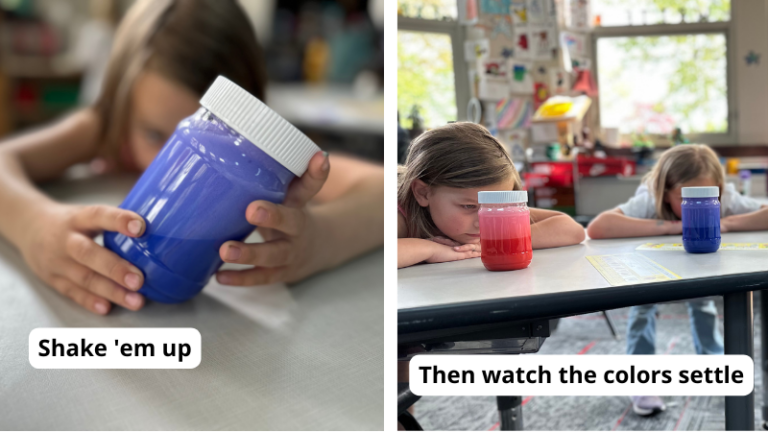Second-grader James is having a rough day. He overslept and was late to school, missing out on breakfast. His best friend is out sick today. At recess, he fell and skinned his knee, and other kids made fun of him for crying a little. Now, it’s time for reading, his most challenging subject. After the third time he makes a mistake and is gently corrected by his teacher, Ms. Hernandez, he’s simply had enough. He throws the book on the floor and shouts that everyone hates him, and he hates them too. Ms. Hernandez asks the rest of the reading group to read silently, then quietly leads James to the classroom calm-down corner.
Calm-down corners are a popular tool in classrooms these days and with good reason. Teachers recognize that kids, like adults, have a lot of feelings and emotions to process throughout the day. Sometimes, it’s all too much, and the result can be bad behavior. A calm-down corner, sometimes known as a peace corner or even Antarctica (a place far away from everyone else), gives kids a place to recenter and refocus so they can join the learning again. Here’s how to build and effectively use one in your classroom.
Just a heads up, WeAreTeachers may collect a share of sales from the links on this page. Thank you for your support!
1. Create a safe and cozy space
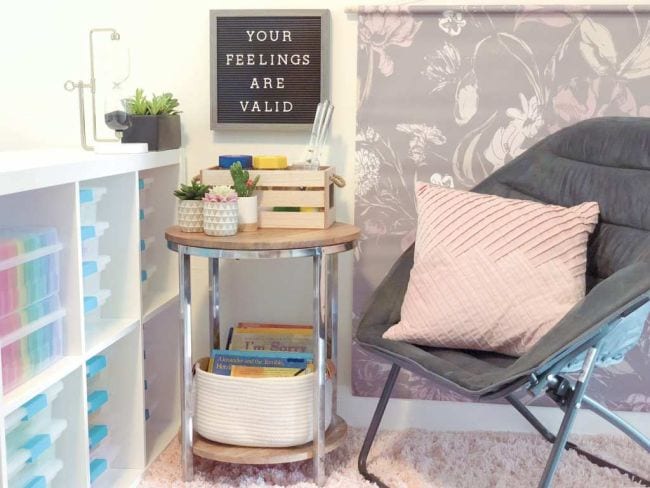
Source: Teaching with Jillian Starr
The best calm-down corners feel a little separated from the rest of the classroom. If you have space, set yours up with a physical barrier of some kind. Low bookshelves work well since teachers can easily see over them, but kids still feel like they’ve got distance from everyone else.
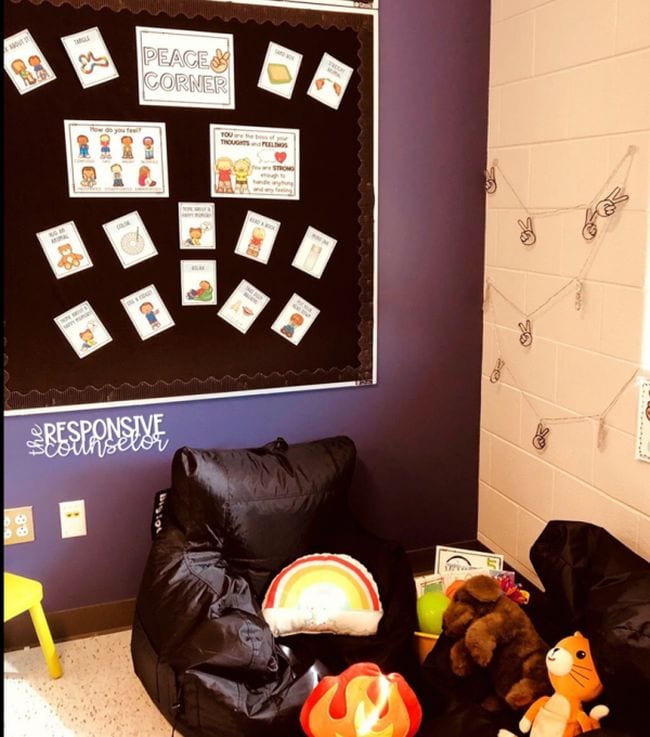
Source: The Responsive Counselor
Make your calm-down corner a space that feels safe and cozy, the kind of place where a kid can just relax for a few minutes. Throw pillows, floor cushions, and a stuffed animal or two can create just the peaceful atmosphere you’re looking for.
If you don’t have a lot of space in your classroom, think creatively. Give kids the illusion of separation by letting them turn their back to the rest of the classroom. Have them sit on the floor under a desk or table, and provide noise-canceling headphones so they can block out what’s around them. The point is to find a space where kids can tune out the rest of the world for a few minutes and focus on processing their feelings.
2. Provide guides to calm down
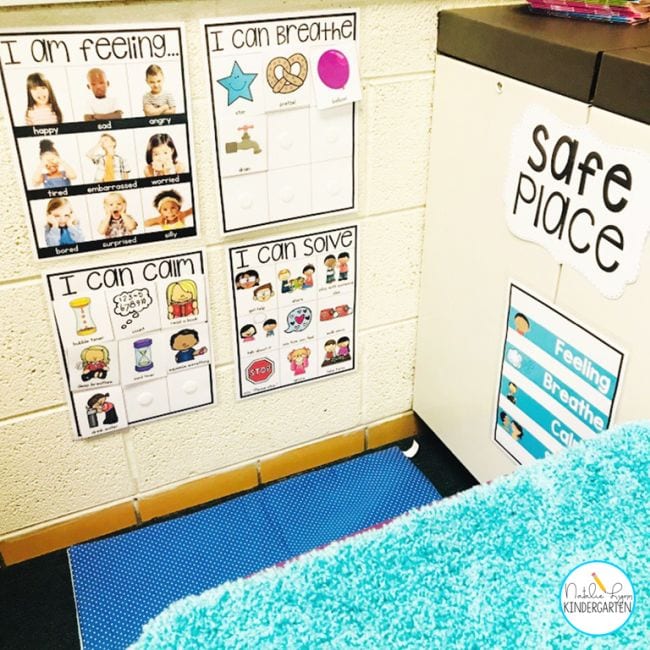
Source: Natalie Lynn Kindergarten
Sending kids to a safe space is a good start, but they’ll need help to calm down and refocus once they’re there. If you have the wall space, hang posters and signs to guide them. This kit from Natalie Lynn Kindergarten has terrific resources for helping students identify how they’re feeling and find ways to regain their calm.
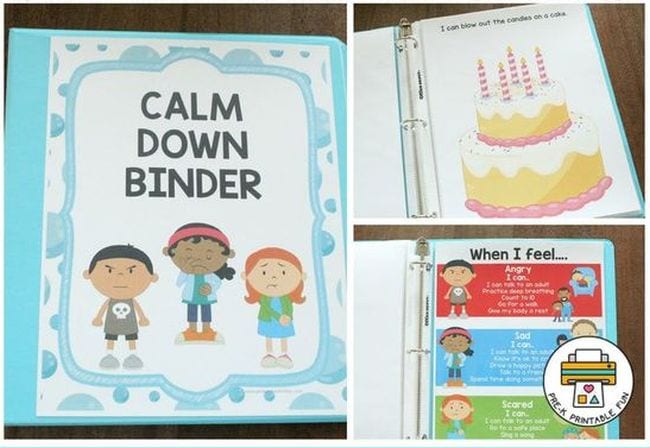
Source: Pre-K Printable Fun
No room for signs, or want the ability to take your calm tools with you? Try a binder instead. This one from Pre-K Printable Fun has a nice selection of exercises kids can use anywhere when they need to find a sense of peace.
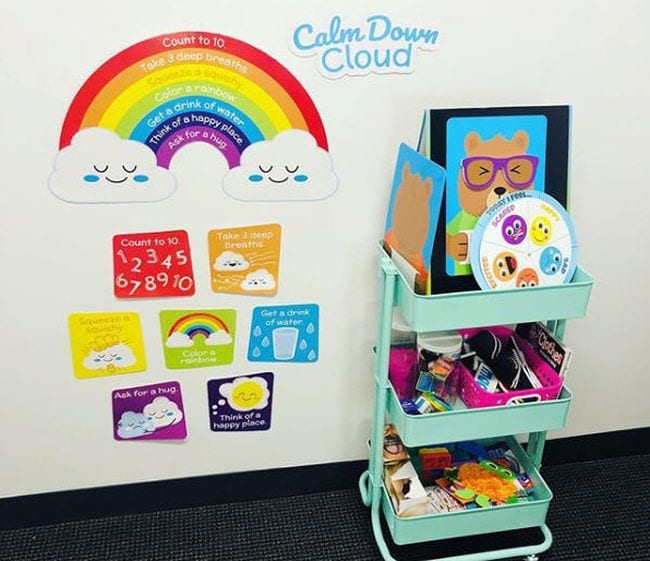
Source: The Social Emotional Teacher
Here’s another option we really like: the Calm Down Cloud pack from Oriental Trading. The cheerful colors and truly helpful ideas are bound to be popular with students.
3. Offer calming books
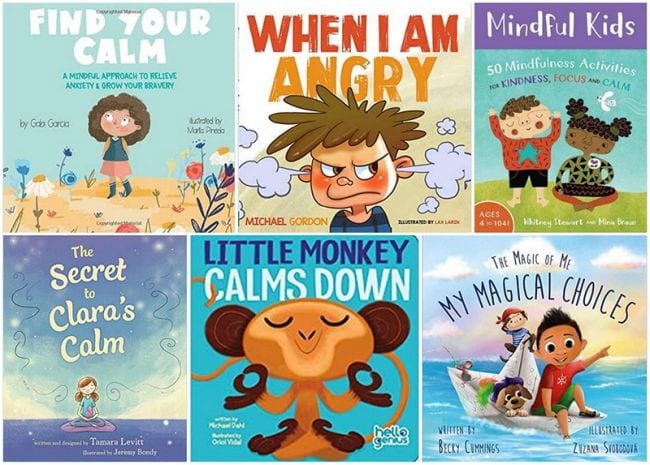
There are so many amazing books focused on helping kids with social emotional learning . Add a few to your classroom library to use for read-alouds, and keep them in your calm-down corner for kids to look at when they need them most. Here are a few of our favorites.
- Find Your Calm (Garcia/Pineda): The narrator in this book does a great job describing what anxiety can feel like (“My body feels like it’s moving in every different direction. I’m overwhelmed.”) It acknowledges those big feelings, and provides thoughtful suggestions for overcoming them.
- When I Am Angry (Gordon): Anger is a powerful emotion. This rhyming book for young readers helps them understand that anger is natural, but we need to find safe ways to handle it.
- Mindful Kids: 50 Mindfulness Activities: Not a book, but a set of 50 cards containing mindfulness and meditation activities. Kids can sort through to find one that works for them.
- The Secret to Clara’s Calm (Levitt/Bondy): Clara is cheerful and fun, popular with the other kids. But she also has a nasty temper when things go wrong. Fortunately, a bird named Brodhi is on hand to teach her the secret to finding her calm.
- Little Monkey Calms Down (Dahl): This cute book is ideal for the pre-K set. Little Monkey is having a rough day, but he uses simple coping strategies to feel better again.
- The Magic of Me: My Magical Choices (Cummings/Svoboda): This book reminds kids that they can make choices about their behavior, and gives helpful suggestions for making good ones.
4. Add fidget toys and other tools
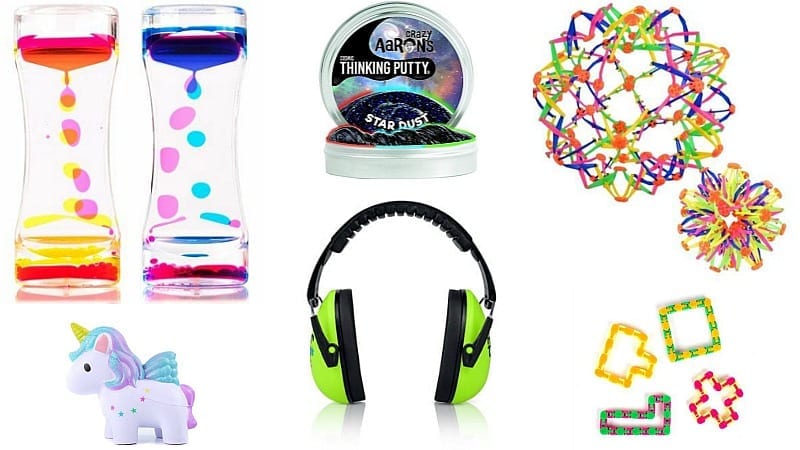
Stock your calm-down corner with a few meaningful toys and tools. A pair of noise-canceling headphones will help overstimulated kids find a little quiet, while fidget toys are an ideal way to work off some nervous energy. Small puzzles or simple building toys give kids something concrete to focus on as they process emotions, and creative outlets like coloring books or handicrafts can be soothing too. Find all of our favorite options for your calm-down kit here.

Calm-down jars are a popular tool, too. Kids will be mesmerized as they shake these jars and watch the colors mix, then magically separate again. Add a little glitter for an even better show! Learn how to make the jars here.
5. Take it digital
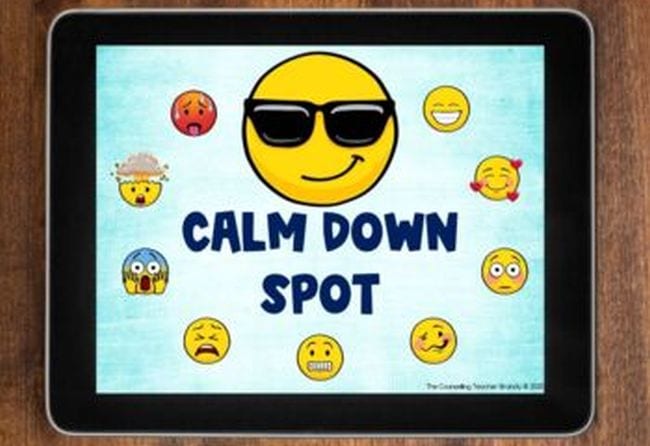
Virtual classrooms have become the new norm in a lot of places right now, so calm-down corners are going digital too! You can use these in an online school environment, or in a traditional classroom. The well-reviewed Digital Calm Down Corner from The Counseling Teacher Brandy has a mood check-in and a nice selection of calming videos and activities. It also pairs well with Google Classroom.
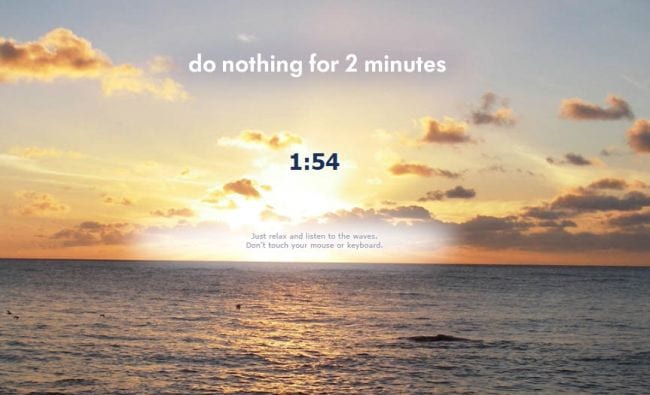
Mindfulness and meditation apps are really useful too. One of our favorites is Do Nothing For Two Minutes. Start the app, then spend two minutes doing nothing but listening to waves as you stare at the ocean. If you move the cursor, the time starts over again. Find more apps to combat anxiety and stress here.
The web is full of wonderful mindfulness and meditation videos for kids too. Keep a playlist handy on a tablet or in your Google Classroom tools for kids to view when they need a few minutes of calm.
6. Teach kids how to use the space
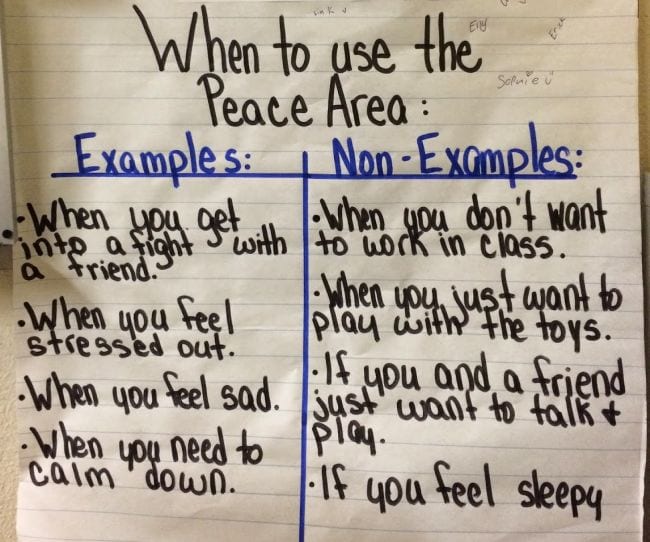
Source: Ms. Sepp’s Counselor Corner
It’s really important that a calm-down corner be a useful tool for kids, rather than something they view as a punishment or playtime. That means you’ll need to spend some time introducing the space and helping students understand how to make it work for them. Work some social emotional learning lessons into your curriculum over the first few days of school, and then open the corner when you feel kids are ready to make good use of it.
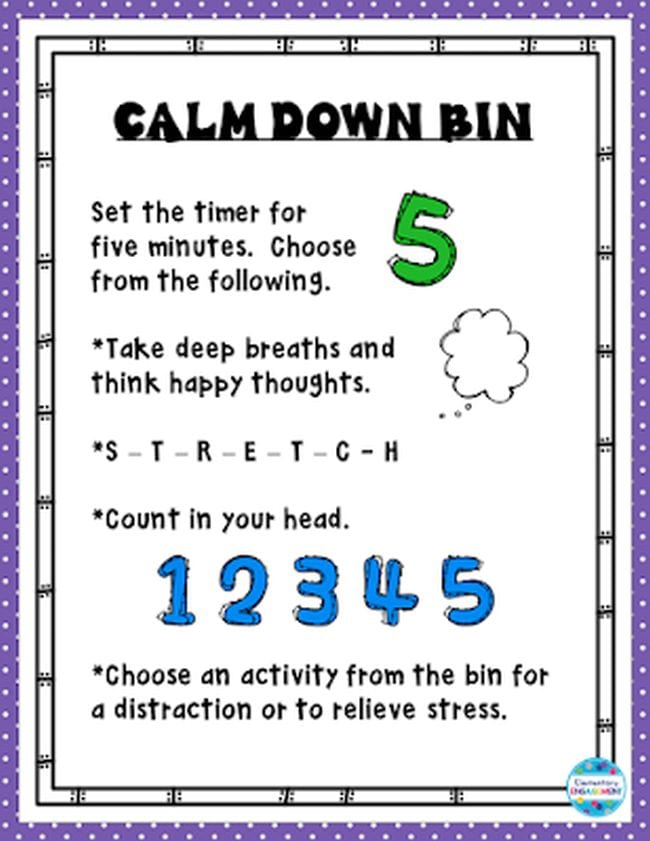
Source: Elementary Engagement
Set rules for the corner. Will students need to ask you before going there, or can they simply take a few minutes there as needed? Unless you have a lot of space, limit the corner to one student at a time so it doesn’t become a place to chat or play. A time limit is a good idea too; have a student set the timer for 5 minutes when they first enter the corner. At the end of 5 minutes, they should feel calm enough to return to class. If not, they can ask you for an extension.
Do you use a calm-down corner in your classroom? Share your tips and ask questions on the WeAreTeachers HELPLINE group on Facebook.

